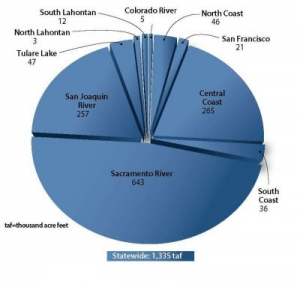California Water Shortage- It’s About the Water
By Michael FaginUncategorizedWith 0 commentsCalifornia Water Shortage – it’s all about water in the Golden State. The need for the liquid is at least as prominent as anywhere else in the country. Quality drinking water is one thing but only accounts for a minute fraction of total usage. Agricultural and other urban uses require a demand magnitudes higher. Some is used to both better and preserve wetlands. Efficient water management also requires saving some and storing it.
Two-thirds of California’s freshwater is sourced from snowmelt from the Sierra Nevada region. The Colorado River is another much needed quench for southern California and also Arizona and Nevada, which must negotiate its usage. A third, often underestimated supply is the 16% of the nation’s groundwater extracted from Californian aquifers. About one part of California’s stocks assists wetlands and two parts each are for urban use and farming.
High demand has led to the formation of several corporate and governmental organizations with the common aim of steering California’s water politics. A new Drought Contingency Plan is being proposed to keep water in Lake Mead, a major reservoir of the Colorado River, from dropping below critical levels. Comprised of farmers wanting to keep more of California’s water stored in the lake, California’s Imperial Irrigation District is in the middle of a lawsuit regarding how much it can use. Even when there is agreement on how much can be used, sometimes the good intent of such plans falls short in practice. For instance, the “Twin tunnels” Californian WaterFix proposal is being challenged in court due to “significant impacts” to the ecosystem and water quality.
California’s Groundwater
California houses plentiful groundwater, with 16.5 million acre feet of aquifers presently used annually. In 2010, the USGS estimated that 13 billion gallons are used per day. Three of four parts of what is extracted from deep under the surface are used for agriculture, with less than 1 part reserved for use in urban areas. Both groundwater and snowmelt runoff fuel farming in the Central Valley: home to 8% of US agriculture and 75% of California’s groundwater. Arid central coastal regions depend most on groundwater. Overall, it accounts for about 40% of state water usage, with higher draws during droughts. Only 8% less than half of the area of the state, 515 alluvial basins with highly variable yields span 62,000 square miles deep under the surface.
It’s a lot of water but still just a matter of time until depleted if precautions aren’t taken. Sustainable basin management means not using more than is being replenished. Groundwater can be replenished through selective infiltration basins such as gravel pits and alluvial fans, which secondarily function to cap reservoirs from evaporation. Water can also be injected into partially full basins and irrigation wells, much deeper and bigger than typical domestic wells. Some diminished quality from extraction is expected but nature typically stores groundwater in good to great condition.

California Water Shortage and drought
In 2014, California’s Sustainable Groundwater Management Act imposed regulations on groundwater usage, requiring critically overdrafted areas to adopt replenishment strategies by 2020. There are 266 groundwater sustainability agencies in the state. [If seeking the newest data, the California Statewide Groundwater Elevation Program (CASGEM) provides groundwater statistics. Also, the government of California supplies data and hydrographs for around 20,000 wells.]
In California it’s all about water consumption but the impacts of its availability or scarcity run even deeper. A drought affects business that at first glance may seem disconnected. Costs rise during scarcity, which ripples through an economy. Well depth level drops can increase pumping costs. The geological forces related to depleting a well can create land subsidence and destroy operability at the site. Naturally sourced, it’s not just water usage that complicates things but also the biosphere related to the flow. Both natural and man-made pollutants tend to concentrate in mostly drained wells, potentially rendering them too contaminated and unusable. Water management officials monitor near coastlines where saline intrusion into the groundwater system is possible. Nature provides well but local abundance can end, sometimes abruptly, due to diminished quantity or quality.
Weather in California – It’s All About Water and Wind
Is the need for water going to be the death of California? A look at the regional wildfires and droughts lends to the concern. Snowpack variation exists because snow tends to fall regionally but, overall, California has endured a low snowpack trend. Snowmelt is a primary driver of the Californian economy, raising popular forebodings of tragedy years away and irreversible regional climate change.
A low snowpack trend is far from permanent on the West Coast, which is prone to precipitation whiplash – extreme wet/dry events happening cyclically. Bone dry ground can quickly turn into frequent flash flooding once the cycle changes.
Whereas dry-to-wet periods may last several years before reversing, annual cycles and trends also contribute to precipitation pattern changes. Winds favoring warmer winters tend to produce less snowfall. Extra precipitation may lead to a deepening of the snowpack but not if it’s too warm and falls as rain.
Snowpack melt is also very regionally dependent. For example, Lake Oroville – a crucial component of the water system feeding Southern California and the Central Valley – saw record winter 2017 proximate snowfall which led to notable flooding.
The news about the water supply in California is not all bad. New aquifers are still being discovered and there is room for development. The new sustainability projects are aiming to maintain supplies, which should slow depletion for decades. As easily expected, Californians are dramatically expanding water usage in newly developed areas but, otherwise, citizens have been well adapting to droughts and the need to lower consumption, not yet having returned to 2013 highs. The population is rising on the West Coast but so is wisdom about what to do with the water
Written by Meteorologist Geoff Linsley
